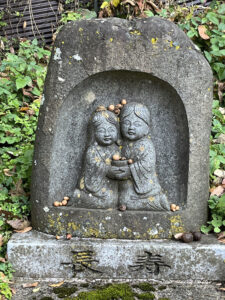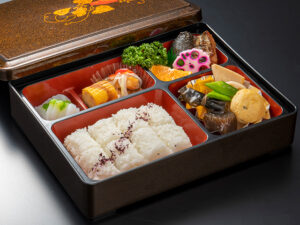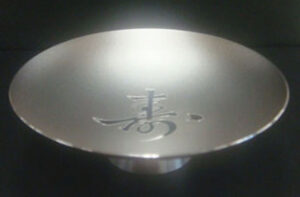
A Good, Long Life
Mayumi’s parents live in the center of Japan in Nagano Prefecture, the site of the 1998 Winter Olympics. They are surrounded by heavily forested foothills, with gorgeous vistas of the Japan Alps. For walkers, it doesn’t get much better than Nagano.
On our last trip, we came across this weather-worn stone statue of a happy couple. The two ideographs on the base read choju, meaning long life. The second ideograph, on its own, reads kotobuki, with a powerful sense of celebration. If you look closely, you’ll see that walkers have piled acorns on the happy couple to acknowledge their good fortune.

Japan is best in class at choju. The average life expectancy in Japan is now over 84 years and increasing. By comparison, the figure is 77.28 in America, and decreasing. Even more telling, is healthy life expectancy (age before onset of major disease). Japanese are much, much better at staying healthy later in life.
A Powerful Health Technology
A reason is one of the world’s most powerful health technologies—the bento box.
Served in a compartmented box, the bento celebrates the season with a complete selection of vegetables, carbohydrates, protein, and fruit. No willpower required. Portion control comes with the box. It is a visual feast and (usually) delicious.

It must be working. Japan has a 3% obesity rate compared to the 30% in the US. And we can’t blame genetics. Japanese immigrants to the US soon acquire similar rates of obesity and cardiovascular disease as their American brethren.
Japan as Number One
Japan also excels at the per-capita production of centenarians.
1950 97
2022 90,526
2050 440,000 (est.)
The phenomenon of Japan’s aging population has been closely studied for decades. Mike first wrote on the subject for the Wall Street Journal in 1990. The current birth rate (1.27) is little more than half of replacement. As a result, the Japanese population now looks to plunge below the 100 million floor much sooner than anyone expected.

Image source: Japan Times
A lovely tradition, and no big deal when 97 people hit the century mark. But, in 2015, the government threatened to end the custom. At 8,000 yen per cup (roughly $80 in 2015) the government apparently feared a sakazuki tsunami. Sadly, some hapless economist deep in the Ministry of Finance calculated the miniscule savings to the nation, while overlooking the monumental contribution of this cohort to the wealth of the realm.
The good news is that future centenarians rose up in arms and got the sakazuki death sentence commuted. But now the cups are smaller and made of nickel. There’s also an active return buying service for when centenarians shuffle off this mortal coil.
But, hey, a good, long life is worth celebrating, wherever you may live. Wishing you a sakazuki in your future. As Americans, we say “Why wait?” Ask someone you love to buy you the snazzy silver version. We guarantee the sake will taste delicious. To your good, long life! Kanpai!
![]()
